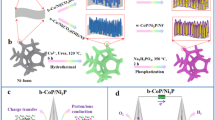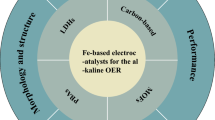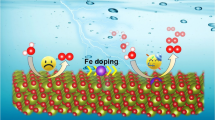Abstract
Developing high-performance nonprecious-metal electrocatalysts for the oxygen reduction reaction (ORR) is crucial for a variety of renewable energy conversion and storage systems. Toward that end, rational catalyst design principles that lead to highly active catalytic centers and enhanced active site accessibility are undoubtedly of paramount importance. Here, we used Prussian blue nanoparticles to anchor Fe/Fe3C species to nitrogen-doped reduced graphene oxide aerogels as ORR catalysts. The strong interaction between nanosized Fe3C and the graphitic carbon shell led to synergistic effects in the ORR, and the protection of the carbon shell guaranteed stability of the catalyst. As a result, the aerogel electrocatalyst displayed outstanding activity in the ORR on par with the state-of-the-art Pt/C catalyst at the same mass loading in alkaline media, good performance in acidic media, and excellent stability and crossover tolerance that rivaled that of the best nonprecious-metal ORR electrocatalysts reported to date.

Similar content being viewed by others
References
Wu, G.; Zelenay, P. Nanostructured nonprecious metal catalysts for oxygen reduction reaction. Acc. Chem. Res. 2013, 46, 1878–1889.
Lefèvre, M.; Proietti, E.; Jaouen, F.; Dodelet, J. P. Iron-based catalysts with improved oxygen reduction activity in polymer electrolyte fuel cells. Science 2009, 324, 71–74.
Debe, M. K. Electrocatalyst approaches and challenges for automotive fuel cells. Nature 2012, 486, 43–51.
Wang, Z. L.; Xu, D.; Xu, J. J.; Zhang, X. B. Oxygen electrocatalysts in metal-air batteries: From aqueous to nonaqueous electrolytes. Chem. Soc. Rev. 2014, 43, 7746–7786.
Huang, X. Q.; Zhao, Z. P.; Cao, L.; Chen, Y.; Zhu, E. B.; Lin, Z. Y.; Li, M. F.; Yan, A. M.; Zettl, A.; Wang, Y. M. et al. High-performance transition metal-doped Pt3Ni octahedra for oxygen reduction reaction. Science 2015, 348, 1230–1234.
Chen, Z. W.; Higgins, D.; Yu, A. P.; Zhang, L.; Zhang, J. J. A review on non-precious metal electrocatalysts for PEM fuel cells. Energy Environ. Sci. 2011, 4, 3167–3192.
Chung, D. Y.; Kim, H. I.; Chung, Y. H.; Lee, M. J.; Yoo, S. J.; Bokare, A. D.; Choi, W.; Sung, Y. E. Inhibition of CO poisoning on Pt catalyst coupled with the reduction of toxic hexavalent chromium in a dual-functional fuel cell. Sci. Rep. 2014, 4, 7450.
Ma, X. M.; Meng, H.; Cai, M.; Shen, P. K. Bimetallic carbide nanocomposite enhanced Pt catalyst with high activity and stability for the oxygen reduction reaction. J. Am. Chem. Soc. 2012, 134, 1954–1957.
Yin, H. J.; Tang, H. J.; Wang, D.; Gao, Y.; Tang, Z. Y. Facile synthesis of surfactant-free Au cluster/graphene hybrids for high-performance oxygen reduction reaction. ACS Nano 2012, 6, 8288–8297.
Zhao, S. L.; Yin, H. J.; Du, L.; Yin, G. P.; Tang, Z. Y.; Liu, S. Q. Three dimensional N-doped graphene/PtRu nanoparticle hybrids as high performance anode for direct methanol fuel cells. J. Mater. Chem. A 2014, 2, 3719–3724.
Zhou, R. F.; Qiao, S. Z. An Fe/N co-doped graphitic carbon bulb for high-performance oxygen reduction reaction. Chem. Commun. 2015, 51, 7516–7519.
Zhang, J. T.; Zhao, Z. H.; Xia, Z. H.; Dai, L. M. A metalfree bifunctional electrocatalyst for oxygen reduction and oxygen evolution reactions. Nat. Nanotechnol. 2015, 10, 444–452.
Wu, Z. S.; Chen, L.; Liu, J. Z.; Parvez, K.; Liang, H. W.; Shu, J.; Sachdev, H.; Graf, R.; Feng, X. L.; Müllen, K. Highperformance electrocatalysts for oxygen reduction derived from cobalt porphyrin-based conjugated mesoporous polymers. Adv. Mater. 2014, 26, 1450–1455.
Lin, L.; Zhu, Q.; Xu, A. W. Noble-metal-free Fe-N/C catalyst for highly efficient oxygen reduction reaction under both alkaline and acidic conditions. J. Am. Chem. Soc. 2014, 136, 11027–11033.
Niu, W. H.; Li, L. G.; Liu, X. J.; Wang, N.; Liu, J.; Zhou, W. J.; Tang, Z. H.; Chen, S. W. Mesoporous N-doped carbons prepared with thermally removable nanoparticle templates: An efficient electrocatalyst for oxygen reduction reaction. J. Am. Chem. Soc. 2015, 137, 5555–5562.
Ma, R. G.; Ren, X. D.; Xia, B. Y.; Zhou, Y.; Sun, C.; Liu, Q.; Liu, J. J.; Wang, J. C. Novel synthesis of N-doped graphene as an efficient electrocatalyst towards oxygen reduction. Nano Res. 2016, 9, 808–819.
Lei, Y. P.; Shi, Q.; Han, C.; Wang, B.; Wu, N.; Wang, H.; Wang, Y. D. N-doped graphene grown on silk cocoonderived interconnected carbon fibers for oxygen reduction reaction and photocatalytic hydrogen production. Nano Res. 2016, 9, 2498–2509.
Liu, Z. Y.; Zhang, G. X.; Lu, Z. Y.; Jin, X. Y.; Chang, Z.; Sun, X. M. One-step scalable preparation of N-doped nanoporous carbon as a high-performance electrocatalyst for the oxygen reduction reaction. Nano Res. 2013, 6, 293–301.
Liang, Y. Y.; Li, Y. G.; Wang, H. L.; Zhou, J. G.; Wang, J.; Regier, T.; Dai, H. J. Co3O4 nanocrystals on graphene as a synergistic catalyst for oxygen reduction reaction. Nat. Mater. 2011, 10, 780–786.
Xia, W.; Zou, R. Q.; An, L.; Xia, D. G.; Guo, S. J. A metal-organic framework route to in situ encapsulation of Co@Co3O4@C core@bishell nanoparticles into a highly ordered porous carbon matrix for oxygen reduction. Energy Environ. Sci. 2015, 8, 568–576.
Wu, Z.-S.; Yang, S. B.; Sun, Y.; Parvez, K.; Feng, X. L.; Mü llen, K. 3D nitrogen-doped graphene aerogel-supported Fe3O4 nanoparticles as efficient electrocatalysts for the oxygen reduction reaction. J. Am. Chem. Soc. 2012, 134, 9082–9085.
Fu, G. T.; Liu, Z. Y.; Zhang, J. F.; Wu, J. Y.; Xu, L.; Sun, D. M.; Zhang, J. B.; Tang, Y. W.; Chen, P. Spinel MnCO2O4 nanoparticles cross-linked with two-dimensional porous carbon nanosheets as a high-efficiency oxygen reduction electrocatalyst. Nano Res. 2016, 9, 2110–2122.
Wei, P. J.; Yu, G. Q.; Naruta, Y.; Liu, J. G. Covalent grafting of carbon nanotubes with a biomimetic heme model compound to enhance oxygen reduction reactions. Angew. Chem., Int. Ed. 2014, 53, 6659–6663.
Cao, R. G.; Thapa, R.; Kim, H.; Xu, X. D.; Kim, M. G.; Li, Q.; Park, N.; Liu, M. L.; Cho, J. Promotion of oxygen reduction by a bio-inspired tethered iron phthalocyanine carbon nanotube-based catalyst. Nat. Commun. 2013, 4, 2076.
Tang, H. J.; Yin, H. J.; Wang, J. Y.; Yang, N. L.; Wang, D.; Tang, Z. Y. Molecular architecture of cobalt porphyrin multilayers on reduced graphene oxide sheets for highperformance oxygen reduction reaction. Angew. Chem., Int. Ed. 2013, 52, 5585–5589.
Wu, G.; More, K. L.; Johnston, C. M.; Zelenay, P. Highperformance electrocatalysts for oxygen reduction derived from polyaniline, iron, and cobalt. Science 2011, 332, 443–447.
Hu, Y.; Jensen, J. O.; Zhang, W.; Cleemann, L. N.; Xing, W.; Bjerrum, N. J.; Li, Q. F. Hollow spheres of iron carbide nanoparticles encased in graphitic layers as oxygen reduction catalysts. Angew. Chem., Int. Ed. 2014, 53, 3675–3679.
Xiao, M. L.; Zhu, J. B.; Feng, L. G.; Liu, C. P.; Xing, W. Meso/macroporous nitrogen-doped carbon architectures with iron carbide encapsulated in graphitic layers as an efficient and robust catalyst for the oxygen reduction reaction in both acidic and alkaline solutions. Adv. Mater. 2015, 27, 2521–2527.
Zhao, D.; Shui, J. L.; Chen, C.; Chen, X. Q.; Reprogle, B. M.; Wang, D. P.; Liu, D. J. Iron imidazolate framework as precursor for electrocatalysts in polymer electrolyte membrane fuel cells. Chem. Sci. 2012, 3, 3200–3205.
Lee, J. S.; Park, G. S.; Kim, S. T.; Liu, M. L.; Cho, J. A highly efficient electrocatalyst for the oxygen reduction reaction: N-doped ketjenblack incorporated into Fe/Fe3Cfunctionalized melamine foam. Angew. Chem. Int. Ed. 2013, 52, 1026–1030.
Wu, Z. Y.; Xu, X. X.; Hu, B. C.; Liang, H. W.; Lin, Y.; Chen, L. F.; Yu, S. H. Iron carbide nanoparticles encapsulated in mesoporous Fe-N-doped carbon nanofibers for efficient electrocatalysis. Angew. Chem., Int. Ed. 2015, 54, 8179–8183.
Zhang, S. M.; Zhang, H. Y.; Liu, Q.; Chen, S. L. Fe-N doped carbon nanotube/graphene composite: Facile synthesis and superior electrocatalytic activity. J. Mater. Chem. A 2013, 1, 3302–3308.
Masa, J.; Xia, W.; Muhler, M.; Schuhmann, W. On the role of metals in nitrogen-doped carbon electrocatalysts for oxygen reduction. Angew. Chem., Int. Ed. 2015, 54, 10102–10120.
Huang, H.; Feng, X.; Du, C. C.; Wu, S. Y.; Song, W. B. One-step pyrolytic synthesis of small iron carbide nanoparticles/ 3D porous nitrogen-rich graphene for efficient electrocatalysis. J. Mater. Chem. A 2015, 3, 4976–4982.
Pintado, S.; Goberna-Ferrón, S.; Escudero-Adán, E. C.; Galán-Mascaró s, J. R. Fast and persistent electrocatalytic water oxidation by Co-Fe Prussian blue coordination polymers. J. Am. Chem. Soc. 2013, 135, 13270–13273.
Lee, J. S.; Nam, G.; Sun, J.; Higashi, S.; Lee, H. W.; Lee, S.; Chen, W.; Cui, Y.; Cho, J. Composites of a Prussian blue analogue and gelatin-derived nitrogen-doped carbon-supported porous spinel oxides as electrocatalysts for a Zn–air battery. Adv. Energy Mater., in press, DOI: 10.1002/aenm.201601052.
Xia, W.; Mahmood, A.; Zou, R. Q.; Xu, Q. Metal-organic frameworks and their derived nanostructures for electrochemical energy storage and conversion. Energ. Environ. Sci. 2015, 8, 1837–1866.
Zhao, S. L.; Yin, H. J.; Du, L.; He, L. C.; Zhao, K.; Chang, L.; Yin, G. P.; Zhao, H. J.; Liu, S. Q.; Tang, Z. Y. Carbonized nanoscale metal-organic frameworks as high performance electrocatalyst for oxygen reduction reaction. ACS Nano 2014, 8, 12660–12668.
Hou, Y.; Huang, T. Z.; Wen, Z. H.; Mao, S.; Cui, S. M.; Chen, J. H. Metal-organic framework-derived nitrogendoped core–shell-structured porous Fe/Fe3C@C nanoboxes supported on graphene sheets for efficient oxygen reduction reactions. Adv. Energy Mater. 2014, 4, 1400337.
Ma, T. Y.; Dai, S.; Jaroniec, M.; Qiao, S. Z. Metal-organic framework derived hybrid Co3O4-carbon porous nanowire arrays as reversible oxygen evolution electrodes. J. Am. Chem. Soc. 2014, 136, 13925–13931.
Mao, S.; Lu, G. H.; Chen, J. H. Three-dimensional graphenebased composites for energy applications. Nanoscale 2015, 7, 6924–6943.
Kong, B. A.; Sun, X. T.; Selomulya, C.; Tang, J.; Zheng, G. F.; Wang, Y. Q.; Zhao, D. Y. Sub-5 nm porous nanocrystals: Interfacial site-directed growth on graphene for efficient biocatalysis. Chem. Sci. 2015, 6, 4029–4034.
Cui, X. Y.; Yang, S. B.; Yan, X. X.; Leng, J. G.; Shuang, S.; Ajayan, P. M.; Zhang, Z. J. Pyridinic-nitrogen-dominated graphene aerogels with Fe–N–C coordination for highly efficient oxygen reduction reaction. Adv. Funct. Mater. 2016, 26, 5708–5717.
Xu, J. B.; Zhao, T. S. Mesoporous carbon with uniquely combined electrochemical and mass transport characteristics for polymer electrolyte membrane fuel cells. RSC Adv. 2013, 3, 16–24.
Jeong, H. M.; Lee, J. W.; Shin, W. H.; Choi, Y. J.; Shin, H. J.; Kang, J. K.; Choi, J. W. Nitrogen-doped graphene for high-performance ultracapacitors and the importance of nitrogen-doped sites at basal planes. Nano Lett. 2011, 11, 2472–2477.
Kobayashi, M.; Niwa, H.; Saito, M.; Harada, Y.; Oshima, M.; Ofuchi, H.; Terakura, K.; Ikeda, T.; Koshigoe, Y.; Ozaki, J. et al. Indirect contribution of transition metal towards oxygen reduction reaction activity in iron phthalocyaninebased carbon catalysts for polymer electrolyte fuel cells. Electrochim. Acta 2012, 74, 254–259.
Deng, D. H.; Yu, L.; Chen, X. Q.; Wang, G. X.; Jin, L.; Pan, X. L.; Deng, J.; Sun, G. Q.; Bao, X. H. Iron encapsulated within pod-like carbon nanotubes for oxygen reduction reaction. Angew. Chem., Int. Ed. 2013, 52, 371–375.
Acknowledgements
We acknowledge the support from Global Climate and Energy Projects (GCEP) at Stanford University.
Author information
Authors and Affiliations
Corresponding author
Electronic supplementary material
12274_2016_1300_MOESM1_ESM.pdf
A Prussian blue route to nitrogen-doped graphene aerogels as efficient electrocatalysts for oxygen reduction with enhanced active site accessibility
Rights and permissions
About this article
Cite this article
Liu, Y., Wang, H., Lin, D. et al. A Prussian blue route to nitrogen-doped graphene aerogels as efficient electrocatalysts for oxygen reduction with enhanced active site accessibility. Nano Res. 10, 1213–1222 (2017). https://doi.org/10.1007/s12274-016-1300-x
Received:
Revised:
Accepted:
Published:
Issue Date:
DOI: https://doi.org/10.1007/s12274-016-1300-x




